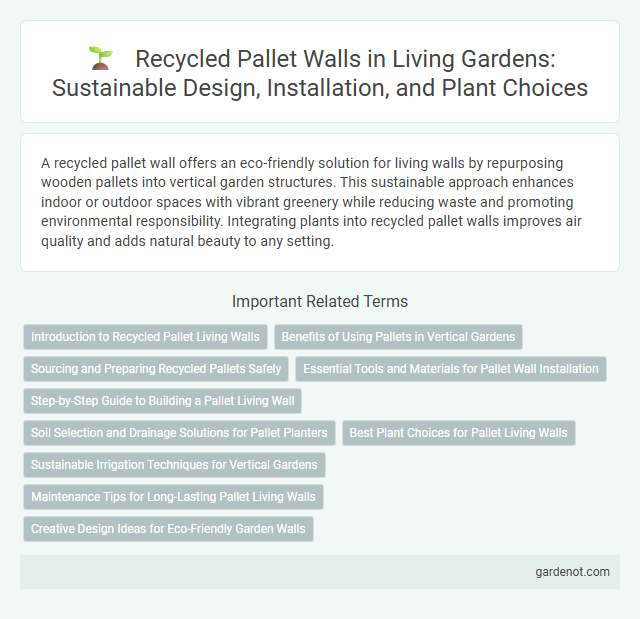A recycled pallet wall offers an eco-friendly solution for living walls by repurposing wooden pallets into vertical garden structures. This sustainable approach enhances indoor or outdoor spaces with vibrant greenery while reducing waste and promoting environmental responsibility. Integrating plants into recycled pallet walls improves air quality and adds natural beauty to any setting.
Introduction to Recycled Pallet Living Walls
Recycled pallet living walls transform discarded wood pallets into sustainable, eco-friendly vertical gardens that enhance urban spaces. These walls support various plant species, improve air quality, and reduce carbon footprints by reusing materials that would otherwise contribute to landfill waste. Integrating recycled pallets as structural elements promotes green architecture while offering an affordable and customizable solution for indoor and outdoor environments.
Benefits of Using Pallets in Vertical Gardens
Recycled pallet walls offer an eco-friendly solution for vertical gardens by repurposing wood that would otherwise contribute to landfill waste. Using pallets promotes sustainability, reduces costs, and provides excellent structure for plant growth with natural ventilation and drainage. Pallet walls also enhance urban spaces by maximizing green areas in limited spaces, supporting biodiversity, and improving air quality.
Sourcing and Preparing Recycled Pallets Safely
Sourcing recycled pallets requires verifying that they are heat-treated and free from chemical contamination to ensure safe use for living walls. Thoroughly cleaning and sanding the pallets removes dirt and splinters, creating a stable and secure surface for plant installation. Proper preparation extends the lifespan of the pallet wall and prevents potential hazards such as mold or pest infestation.
Essential Tools and Materials for Pallet Wall Installation
Essential tools for installing a recycled pallet living wall include a power drill, measuring tape, level, and a jigsaw for precise cuts. Materials such as pressure-treated pallets, mounting brackets, screws, landscape fabric, and a waterproof backing ensure stability and protect the wall from moisture damage. Using eco-friendly finishes or sealants preserves the wood's longevity while enhancing the aesthetic appeal of the vertical garden.
Step-by-Step Guide to Building a Pallet Living Wall
Create a recycled pallet living wall by first selecting a sturdy, untreated pallet and securing landscape fabric to the back and bottom to hold soil. Fill the pallet compartments with nutrient-rich soil and choose a variety of drought-tolerant plants or succulents for easy maintenance. Mount the pallet vertically on a sturdy wall or fence using heavy-duty brackets, ensuring proper drainage and regular watering to establish a thriving green wall.
Soil Selection and Drainage Solutions for Pallet Planters
Selecting nutrient-rich, lightweight soil with excellent water retention yet quick drainage is critical for recycled pallet walls to ensure healthy plant growth. Incorporating a well-designed drainage layer such as gravel or expanded clay at the planter base prevents waterlogging and root rot. Optimizing soil composition with organic compost enhances moisture balance, while drainage solutions maintain airflow and prevent structural damage to the pallet planter.
Best Plant Choices for Pallet Living Walls
Succulent varieties such as Echeveria and Sedum thrive on recycled pallet living walls due to their low water requirements and shallow root systems. Ferns and trailing plants like English ivy also perform well by providing lush greenery and cascading effects. Incorporating herbs such as thyme and oregano offers both aesthetic appeal and functional use, enhancing the versatility of pallet living walls.
Sustainable Irrigation Techniques for Vertical Gardens
Recycled pallet walls offer an eco-friendly structure for vertical gardens while incorporating sustainable irrigation techniques such as drip systems and rainwater harvesting to minimize water waste. These methods ensure efficient water delivery directly to plant roots, reducing runoff and evaporation. Integrating biodegradable materials and moisture sensors further enhances water conservation in living walls.
Maintenance Tips for Long-Lasting Pallet Living Walls
Regularly inspect recycled pallet walls for moisture damage and treat with eco-friendly sealants to prevent rot and insect infestations. Ensure proper drainage by maintaining gaps between pallets and avoid overwatering plants to reduce mold growth. Clean leaves and debris frequently to promote airflow and extend the lifespan of the pallet living wall.
Creative Design Ideas for Eco-Friendly Garden Walls
Recycled pallet walls transform discarded wood into stylish, sustainable garden features, offering a unique blend of rustic charm and eco-conscious design. These walls provide an ideal structure for climbing plants and vertical gardens, maximizing green space in small yards while reducing waste. Incorporating colorful paint or natural finishes enhances the visual appeal, creating a vibrant, environmentally friendly living wall.
Recycled pallet wall Infographic

 gardenot.com
gardenot.com